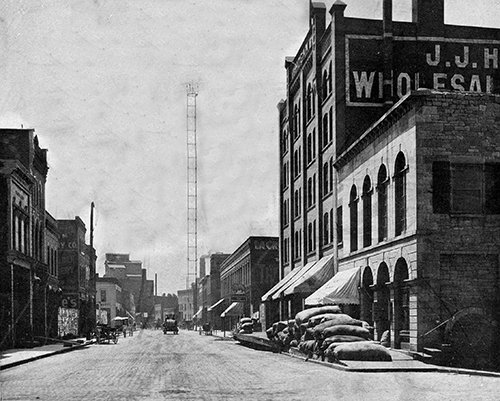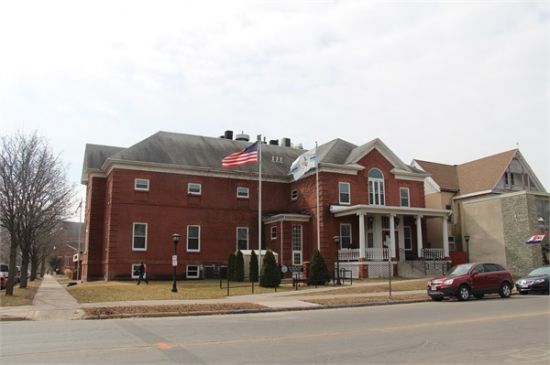
Neighbors Making History: Alexander Gordon & An Artistic Jewel
(written by Jeff Rand, retired Adult Services librarian)
Before photography, people’s images were captured by artists mainly with sketches or paintings. It is no accident that most of these images are of famous people who could afford, or were of sufficient public interest, to have their likenesses preserved by artists.
George Washington, the first president of the United States, was one such person. The best-known images of him were created by Gilbert Stuart from 1795 to 1796. Stuart’s full-length portrait of Washington is known as the “Lansdowne” because its original owner was former British Prime Minister Marquise of Lansdowne. Stuart’s original Washington portrait is now owned by the Pennsylvania Academy of the Fine Arts.

George Washing portrait by Gilbert Stuart; Image courtesy of the Pennsylvania Academy of the Fine Arts
What is not as well-known is that a La Crosse artist painted a copy of this iconic George Washington painting, and it hangs in a downtown La Crosse building because of the generosity of an early La Crosse businessman.
Alexander Gordon was born in London in 1815. From 1832 to 1857, he operated a drug business in Aberdeen, Scotland. Emigrating to La Crosse, Wisconsin, in the spring of 1858, Gordon went into the grocery business. Later that year, Gordon and Milton Morse formed a partnership to start a wholesale wine and liquor business located on Front Street between Main and Pearl Streets in the heart of the gritty riverfront. Gordon lived at 509 N. 11th Street, where his mother, Barbara, and sister, Margaret, lived with him.
By 1870, Gordon’s business partner was James Langdon, and their liquor business, Gordon & Langdon, was still on South Front Street.

Looking south down Front Street from Main Street, about 1904. Morse & Co., and later Gordon & Langdon, and Gordon & Manville after that, would have been in one of the buildings in the foreground in the late 1800s. The buildings on the right were later demolished to make way for Harborview Plaza. Photo from Philippi Art Souvenior of La Crosse book (1904).
Alexander Gordon had a new business partner, Marvin Manville, by 1876. Gordon & Manville were wholesale dealers of bourbon, wheat and rye whiskies, and importers of cognac, brandies, gins, and cigars. Their office and warehouse were at 109 S. Front Street. They probably did good business with the numerous taverns and brothels along Front and Pearl Streets. Their sales grew to $100,000 (over $3 million in 2024 dollars) by 1881.
By 1885, Gordon & Manville had relocated to 112 N. Front Street.

Front Street looking north, about 1900. Gordon & Manville was located here in the mid-1880s. The buildings on the left were later demolished to make way for Harborview Plaza. Photo from Philippi Art Souvenior of La Crosse book (1904).
On October 23, 1852, six years before Alexander Gordon came to La Crosse from Scotland, the La Crosse Lodge of Freemasons held its first meeting in the home of Ebenezer Childs. Over the next 50 years, the Freemasons had many different homes until building the Masonic Temple at 8th and Main Streets in 1902. Many of La Crosse’s prominent early citizens were Masons and/or members of the La Crosse Freemasons: Nathan Myrick, T. B. Stoddard, John M. Levy, F. H. Rublee, C. L. Colman, John Paul, Cadwallader Washburn, Mark M. (Brick) Pomeroy, W. R. Finch, George W. Peck, and Angus Cameron, to name a few. By the late 1920s, the La Crosse Masonic Lodge had over 700 members.
In 1859, Alexander Gordon’s brother, J. Gordon, painted a huge 10-foot tall and seven-feet wide portrait of George Washington, who was one of the country’s most well-known Freemasons, that copied the famous Stuart “Lansdowne” original.
And who was “J. Gordon?” There was a 65-year-old James Gordon living in La Crosse at the time of the 1860 United States Census. He was born in Scotland about 1795, and this would have made him 20 years older than Alexander Gordon. James Gordon had a wife named Barbara. Among his five children was a 30-year-old son named Alexander, a 29-year-old daughter named Margaret, and a 19-year-old daughter named Barbara. The overlap in names is intriguing. It is possible that James Gordon named one of his sons, Alexander, after his younger brother; named one of his daughters, Margaret, after his sister Margaret; and one of his other daughters, Barbara, after both his mother and his wife.
James and Barbara Gordon are not listed in the first available (1866) La Crosse city directory. They are not listed in La Crosse at the time of the 1870 United States Census. The June 19, 1875, La Crosse newspaper, Republican & Leader, has a death notice for “Mrs. James Gordon.”We cannot be certain that this is the “J. Gordon” who created the painting in question.
Few rooms in the city were large enough to accommodate Gordon’s huge painting of George Washington. Alexander Gordon offered his brother’s painting to the Masonic Lodge, which formally accepted it in January 1879. Alexander Gordon insisted that the seven-feet by 10-feet painting be framed. Masons Fred Ring and W. A. Roosevelt investigated and determined that the painting could be framed for $27.80 ($880 in 2024 dollars).

Masonic Temple, built in 1902, at 724 Main Street, now a branch office of the Ho-Chunk Nation. Image courtesy of the Wisconsin Historical Society.
The George Washington painting, one of the most prized possessions of the La Crosse Masonic Lodge, has hung in their building ever since. When a famous artist passed through La Crosse in 1908 and saw the Washington painting, he told some local Masons that it was just as good as Stuart’s original.
H. C. Stevens, a member of the local Masonic Lodge, gave a presentation about the history of the painting on December 27, 1912. At that time, he said, “And, my brothers, I have wondered at times as we meet here night after night in the presence of the portrait of the first and greatest man and Mason of our country, if we realize we are possessors of one of the great art treasures that has few, if any, superiors in this country.”
Alexander Gordon died on July 2, 1887, in La Crosse, eight years after his gift of the George Washington painting to the Masonic Lodge. Alexander Gordon’s business in La Crosse sold products that provided temporary pleasure, at best, for some people. His gift of an art masterpiece to a local organization still endures almost 140 years after his death.

Current Masonic Center, 8th and Main Streets. Image courtesy of the Wisconsin Historical Society.
WANT TO LEARN MORE?
Check out Jeff's full article here
